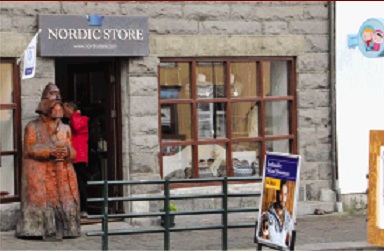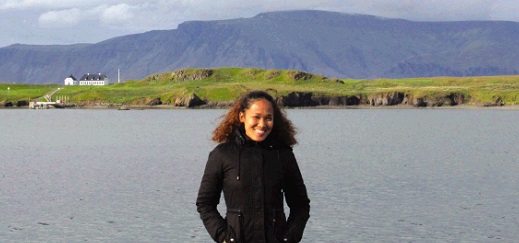Growing up, I remember studying about the country of Iceland in geography class. Images that come to mind are of
ice and ruggedness.
Europe’s last frontieris a place where only the strong and brave could live fighting the elements.
So when I learned that we would be traveling there, I was eager to see if reality matches up to my imagination.
We arrived in the capital city of Reykjavik, which holds the distinction of being the northernmost capital city in the world.
The entire population of Iceland is approximately 333,000 people (which for comparison’s sake is about 70,000 less than Lapu-Lapu City), 123,000 of which live in Reykjavik.
Iceland has recently been experiencing a new wave of tourism, the main draw being its most beautiful natural scenery.
The country is home to geothermal spas, geysers, volcanoes and lava formations. Iceland is also considered as one of the best viewing points for Aurora Borealis, or the Northern Lights.

Hallgrímskirkja is a Lutheran parish church in Reykjavík, Iceland. In front is a statue of Norse explorer Leif Eriksson.
Unfortunately, the Northern Lights—the green, dancing lightsin the sky—are viewable only during certain times of the year and our trip did not coincide with the occurrence.
Iceland is situated so far north that the year is split into a season of complete darkness where the sun never rises, to a season where the sun never sets, called the Midnight Sun, as the sun is still above the horizon at 12 midnight.
The Northern Lights takes place during the dark months, whereas our visit was during the time of the Midnight Sun.
Our first stop was at the iconic Hallgrimskirkja, the Lutheran church that is part of the city’s skyline.
The word “kirkja” is Icelandic for “church” and this one belongs to the Church of Iceland.
Hallgrimskirkja is not only the largest church in Iceland, but also the tallest building in the city.
It took 41 years to complete, starting at the end of World War II in 1945 until 1986.
The plain inside is typical in the Scandinavian Lutheran style.
The outside was designed to resemble the rocky landscape of the country, and it’s meant as a simple place of worship rather than an ornate and flashy show of wealth.
At the church, we witnessed the performance of a visiting organist.
The church’s pipe organ is clearly the focal point of the church interiors.
Of German design, it consists of 5,275 different pipes, is 15 meters tall, and weighs an amazing 25 tons, or more than 22 thousand kilograms.
The natural acoustics of the church allowed for a near perfect natural reverb during the concert.
Outside of the church is a statue of one of the most famous Icelanders in history, Leif Eriksson, the son of famous Viking, Erik the Red.
Leif Eriksson was an explorer who is credited as being the first European to arrive to North America.
According to Icelandic tradition, his discovery predates that of Christopher Columbus by some 500 years before the now-famous 1492 “discovery.”
From leaving a statue dedicated to one of the earliest Icelanders, we walked to one of the newest structures in the city, the Harpa, which is a concert hall in modern design and home to both the Iceland Symphony Orchestra and The Icelandic Opera.
Construction began in 2007 but was stopped in early 2008 at the start of the global economic crisis.
The original plan called not only for a concert hall, but also a 400-room hotel, luxury apartments, shops, restaurants, a parking garage and the headquarters of a bank.

Nordic Store offers a wide range of Icelandic wool sweaters.
The project was scaled back to the basics of the concert hall and conference center and was finally completed in 2011.
We decided to stroll around the shopping areas of the city.
One thing we kept finding was the national dish called Hákari.
The version we saw was still in the package, but the shop owner warned us that the smell is similar to cleaning products due to the high amount of ammonia created during the fermentation process.
The meat of the shark is actually poisonous when fresh, because of the high amount of the chemical urea, but it becomes edible after fermenting.
While the current product nowis more commercialized, the traditional version is made by cutting off the head of the shark, gutting the body, and then throwing it into a hole in the ground.
It is covered with sand, gravel, and stones and is left buried to ferment (basically to rot) for six to 12 weeks depending on the weather conditions.
The body is then dug up, cut into strips, and hung to dry for an additional four to five months.
One can just imagine the odor of meat that has been rotting in various forms. Similar to eating durian, first-timers are told to pinch their nose to get past the smell.
Celebrity chef, author and television host Anthony Bourdain called it one of the worst foods he has ever eaten.
Needless to say, Anna and I decided to skip out on the national dish of Iceland.
Instead, we thought of trying something more representative of the changing culture of Iceland: Vietnamese pho.
It turns out that over the past several decades, what has been considered the typical Icelander is changing.
As the harsh living conditions become more manageable due to advances in technology, more and more people from all over the world are moving to this country.

One of the structures in downtown Reykjavik
Almost 15 percent of the total population are not born in Iceland.
This migration set off another population shift.
As more people started settling down, the population average age also dropped.
Now 20 percent of the residents are under the age of 14.
The country has quickly become younger and more diverse as can be seen in the assorted food outlets such as our Vietnamese restaurant.
While finishing our pho, I realized that Iceland was really no different than most countries in the world, finding itself in a balancing act between its historic past and its bright future.
The only constant in the world is change and that rings true in Iceland.
In the past 100 years, Iceland has moved from a sparsely populated, exotic, frontier land into a modern nation that has quadrupled in population.
The only thing for sure about the future of Iceland is that in another hundred years I’m sure what I just experienced of Iceland will look like distant history.


